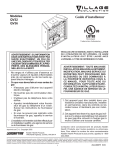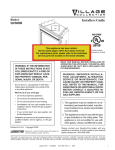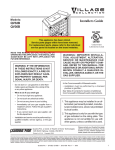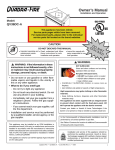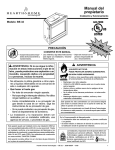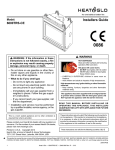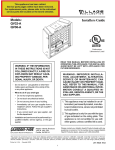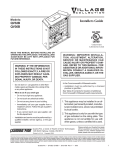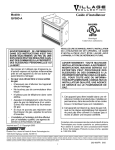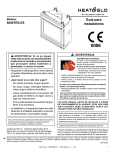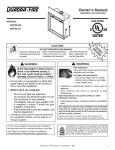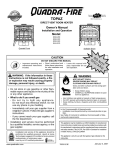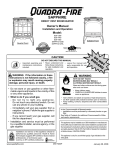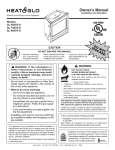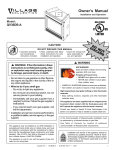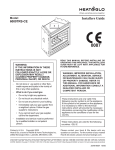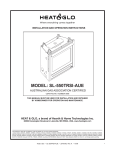Download Hearth and Home Technologies BE-36-CIPI Indoor Fireplace User Manual
Transcript
Models: Installers Guide BE-36-C BE-36-CIPI Underwriters Laboratories Listed WARNING: IF THE INFORMATION IN THESE INSTRUCTIONS IS NOT FOLLOWED EXACTLY, A FIRE OR EXPLOSION MAY RESULT CAUSING PROPERTY DAMAGE, PERSONAL INJURY, OR DEATH. - Do not store or use gasoline or other flammable vapors and liquids in the vicinity of this or any other appliance. - What to do if you smell gas • Do not try to light any appliance. READ THIS MANUAL BEFORE INSTALLING OR OPERATING THIS APPLIANCE. THIS INSTALLERS GUIDE MUST BE LEFT WITH APPLIANCE FOR FUTURE REFERENCE. WARNING: IMPROPER INSTALLATION, ADJUSTMENT, ALTERATION, SERVICE OR MAINTENANCE CAN CAUSE INJURY OR PROPERTY DAMAGE. REFER TO THIS MANUAL. FOR ASSISTANCE OR ADDITIONAL INFORMATION CONSULT A QUALIFIED INSTALLER, SERVICE AGENCY, OR THE GAS SUPPLIER. • Do not touch any electrical switch. • Do not use any phone in your building. • Immediately call your gas supplier from a neighbor's phone. Follow the gas supplier's instructions. • If you cannot reach your gas supplier, call the fire department. - Installation and service must be performed by a qualified installer, service agency, or the gas supplier. Printed in U.S.A. Copyright 2005 Hearth & Home Technologies Inc. 20802 Kensington Boulevard, Lakeville, MN 55044 1. This appliance may be installed in an aftermarket, permanently located, manufactured (mobile) home, where not prohibited by local codes. 2. This appliance is only for use with the type of gas indicated on the rating plate. This appliance is not convertible for use with other gases, unless a certified kit is used. Please contact your Hearth & Home Technologies dealer with any questions or concerns. For the number of your nearest Hearth & Home Technologies dealer, please call 1-800-669-4328. This product may be covered by one or more of the following patents: (United States) 4593510, 4686807, 4766876, 4793322, 4811534, 5000162, 5016609, 5076254, 5113843, 5191877, 5218953, 5263471, 5328356, 5341794, 5347983, 5429495, 5452708, 5542407, 5601073, 5613487, 5647340, 5688568, 5762062, 5775408, 5890485, 5931661, 5941237, 5947112, 5996575, 6006743, 6019099, 6048195, 6053165, 6145502, 6170481, 6237588, 6296474, 6374822, 6413079, 6439226, 6484712, 6543698, 6550687, 6601579, 6672860, 6688302B2, 6715724B2, 6729551, 6736133, 6748940, 6748942, D320652, D445174, D462436; (Canada) 1297749, 2195264, 2225408; or other U.S. and foreign patents pending. Hearth & Home Technologies • BE-36-C, BE-36-CIPI • 397-981 Rev. R • 2/05 1 SAFETY AND WARNING INFORMATION ! ! ! ! ! ! ! ! ! 2 READ and UNDERSTAND all instructions carefully before starting the installation. FAILURE TO FOLLOW these installation instructions may result in a possible fire hazard and will void the warranty. Prior to the first firing of the fireplace, READ the Using Your Fireplace section of the Owners Guide. DO NOT USE this appliance if any part has been under water. Immediately CALL a qualified service technician to inspect the unit and to replace any part of the control system and any gas control which has been under water. ! ! ! THIS UNIT IS NOT FOR USE WITH SOLID FUEL. These units MUST use one of the vent systems described in the Installing the Fireplace section of the Installers Guide. NO OTHER vent systems or components MAY BE USED. This gas fireplace and vent assembly MUST be vented directly to the outside and MUST NEVER be attached to a chimney serving a separate solid fuel burning appliance. Each gas appliance MUST USE a separate vent system. Common vent systems are PROHIBITED. INSPECT the external vent cap on a regular basis to make sure that no debris is interfering with the air flow. The glass door assembly MUST be in place and sealed, and the trim door assembly MUST be in place on the fireplace before the unit can be placed into safe operation. Installation and repair should be PERFORMED by a qualified service person. The appliance and venting system should be INSPECTED before initial use and at least annually by a professional service person. More frequent cleaning may be required due to excessive lint from carpeting, bedding material, etc. It is IMPERATIVE that the unit’s control compartment, burners, and circulating air passageways BE KEPT CLEAN to provide for adequate combustion and ventilation air. ! Always KEEP the appliance clear and free from combustible materials, gasoline, and other flammable vapors and liquids. ! The glass door assembly SHALL ONLY be replaced as a complete unit, as supplied by the gas fireplace manufacturer. NO SUBSTITUTE material may be used. ! DO NOT USE abrasive cleaners on the glass door assembly. DO NOT ATTEMPT to clean the glass door when it is hot. NEVER OBSTRUCT the flow of combustion and ventilation air. Keep the front of the appliance CLEAR of all obstacles and materials for servicing and proper operations. Due to the high temperature, the appliance should be LOCATED out of traffic areas and away from furniture and draperies. Clothing or flammable material SHOULD NOT BE PLACED on or near the appliance. Children and adults should be ALERTED to the hazards of high surface temperature and should STAY AWAY to avoid burns or clothing ignition. Young children should be CAREFULLY SUPERVISED when they are in the same room as the appliance. ! ! DO NOT OPERATE this appliance with the glass door removed, cracked, or broken. Replacement of the glass door should be performed by a licensed or qualified service person. DO NOT strike or slam the glass door. Turn off the gas before servicing this appliance. It is recommended that a qualified service technician perform an appliance check-up at the beginning of each heating season. ! Any safety screen or guard removed for servicing must be replaced before operating this appliance. ! DO NOT place furniture or any other combustible household objects within 36 inches of the fireplace front. Hearth & Home Technologies • BE-36-C, BE-36-CIPI • 397-981 Rev. R • 2/05 TABLE OF CONTENTS Safety and Warning Information ................................................ 2 Service Parts Lists ..................................................................... 4 Section 1: Approvals and Codes ............................................... Appliance Certification................................................................... Installation Codes .......................................................................... High Altitude Installations ............................................................... 8 8 8 8 Section 2: Getting Started ......................................................... 9 Introducing the Hearth & Home Technologies Gas Fireplaces ..... 9 Pre-installation Preparation ........................................................... 9 Section 3: Installing the Fireplace ........................................... 11 Constructing the Fireplace Chase ............................................... 11 Step 1 Locating the Fireplace .................................................. 11 Framing the Fireplace.................................................. 12 Î Step 2 Step 3 Installing the Vent System ............................................ 15 Î A. Vent System Approvals ........................................... 15 B. Installing Vent Components .................................... 23 C. Vent Termination .................................................... 26 Step 4 Positioning, Leveling, and Securing the Fireplace................................................. 29 Step 5 The Gas Control System ............................................. 29 Step 6 The Gas Supply Line ................................................... 30 Step 7 Gas Pressure Requirements ...................................... 30 Step 8 Wiring the Fireplace .................................................... 31 Step 9 Finishing ...................................................................... 34 Step 10 Installing Trim, Logs, and Ember Material.................... 34 Installing the Trim ......................................................... 34 Positioning the Logs .................................................... 34 Shutter Settings ........................................................... 34 Placing the Ember Material .......................................... 35 Glass Specifications .................................................... 35 Step 11 Before Lighting the Fireplace ....................................... 36 Step 12 Lighting the Fireplace .................................................. 36 After the Installation ..................................................................... 36 Section 4: Maintaining and Servicing Your Fireplace ......... 37 Î = Contains updated information. Hearth & Home Technologies • BE-36-C, BE-36-CIPI • 397-981 Rev. R • 2/05 3 BE-36-C, BE-36-CIPI Service Parts Beginning Manufacturing Date: 4-01 Ending Manufacturing Date: ______ (NG, LP) Exploded Parts Diagram (GN, PL) Vue éclatée des pièces 7 5 2 4 3 8 13 14 1 9 Log Set Assembly 6 10 * Part number list on following page. * La liste des numéros de pièce se trouve à la page suivante. 4 12 11 Hearth & Home Technologies • BE-36-C, BE-36-CIPI • 397-981 Rev. R • 2/05 (NG, LP) Service Parts List / Liste des pièces de rechange BE-36-C, BE-36-CIPI IMPORTANT: THIS IS DATED INFORMATION. The most current information is located on your dealers VIP site. When ordering, supply serial and model numbers to ensure correct service parts. / IMPORTANT : L'information fournie dans cette brochure n'est valide que pendant une courte période. Les sites VIP des distributeurs disposent des renseignements les plus récents. Lors d'une commande, veuillez fournir les numéros de série et de modèles pour un remplacement adéquat des pièces. ITEM / PIÈCE Common Parts / Pièces communes SERIAL # / N° DE SÉRIE PART NUMBER / N° DE PIÈCE Burner Orifice NG (#45C) / Orifice de brûleur GN (#45C) 582-845 Burner Orifice LP (#55C) / Orifice de brûleur PL (#55C) 582-855 2 Mesh Assembly / Écran 550-382A 3 Burner Assembly / Module de Brûleur 397-176A 4 Glass Door Assembly / Assemblée de Porte vitrée GLA-550TR 5 Louver, Top / Louvre, supérieure 397-249 6 Louver, Bottom / Louvre, inférieure 397-248 7 Grate Assembly / Module de Grille 397-361A 8 Hood / Hotte SRV550-175 9 Log Assembly / Module de Bûches LOGS-BE36-C 10 Log 1 / Bûche 1 SRV397-701 11 Log 2 / Bûche 2 SRV397-702 12 Log 3 / Bûche 3 SRV397-703 13 Grate Support / Appui de Grille 397-120 Standing Pilot / Veilleuse 14 Conversion Kit LP / Module de conversion PL LPK-BE36-C Junction Box / Boîtier de dérivation 100-250A IPI System / IPI Systeme 1 Junction Box / Boîtier de dérivation PRE 4-04 POST 4-04 383-250A 4021-013 Conversion Kit LP / Module de conversion PL LPK-BE36-CIPI Conversion Kit NG / Module de conversion GN NGK-BE36-CIPI Accessories / Accessoires Gas Inlet Kit (Optional) / Kit d'Admission du Gaz (Facultatif) 531-320A Polished Brass Kit / Module de Laiton PB-BE36 Hearth & Home Technologies • BE-36-C, BE-36-CIPI • 397-981 Rev. R • 2/05 5 BE-36-CIPI Service Parts (NG, LP) Exploded Parts Diagram (GN, PL) Vue éclatée des pièces Intermittent Pilot Ignition Valve Assembly 4 Beginning Manufacturing Date: 4-01 Ending Manufacturing Date: ______ 6 7 15 3 5 1 14 2 8 12 9 11 13 10 ITEM / PIÈCE 6 DESCRIPTION SERIAL # / N° DE SÉRIE PRE POST PRE POST 7-04 7-04 4-04 4-04 PART NUMBER / N° DE PIÈCE 35031 2012-206 040-557A 2045-024 1 Wire Assembly / Module de fil 2 Thermostat Wire Assembly / L'Assemblée de Fil de thermostat 3 Burner Neck Gasket / Joint de Cou de Brûleur 438-407 4 Pilot Assembly NG / Module de veilleuse GN 385-510A 4 Pilot Assembly LP / Module de veilleuse PL 385-511A 5 Valve Bracket / Parenthèse de Valve 2025-101 6 7 8 8 9 Ground Strap / Courroie de Raison(Terre) Pilot Assembly Support / Appui d'Assemblée Pilote Valve NG / Valve GN Valve LP / Valve PL Flexible Gas Connector / Tuyau à gaz flexible 385-512 397-121 593-500 593-501 530-302A 10 11 12 13 Module / Module Wire Assembly / Module de fil Battery Pack / Paquet de Batterie(Pile) 3 Volt Transformer / 3 Transformateur de Volt 593-592 593-590A 593-594A 593-593A 14 Valve Plate Gasket / Joint de Plat de Valve 530-431 15 Pilot Bracket / Parenthèse Pilote 530-164 Hearth & Home Technologies • BE-36-C, BE-36-CIPI • 397-981 Rev. R • 2/05 BE-36-C Service Parts (NG, LP) Exploded Parts Diagram (GN, PL) Vue éclatée des pièces Standing Pilot Ignition Valve Assembly Beginning Manufacturing Date: 4-01 Ending Manufacturing Date: _____ 4 7 2 9 5 6 3 1 8 ITEM / PIÈCE DESCRIPTION SERIAL # / N° DE SÉRIE PART NUMBER / N° DE PIÈCE 1 Piezo Ignitor / Allumeur piézo 291-513 2 Burner Neck Gasket / Joint de Cou de Brûleur 438-407 3 Thermostat Wire Assembly / L'Assemblée de Fil de thermostat 4 Pilot Assembly NG / Module de veilleuse GN 485-510A 4 Pilot Assembly LP / Module de veilleuse PL 485-511A 5 Valve Bracket / Parenthèse de Valve 2025-101 6 Valve Plate Gasket / Joint de Plat de Valve 530-431 7 Pilot Bracket / Parenthèse Pilote 530-164 8 Valve NG / Valve GN 060-520 8 Valve LP / Valve PL 060-521 9 Flexible Gas Connector / Tuyau à gaz flexible 530-302A PRE 4-04 POST 4-04 Hearth & Home Technologies • BE-36-C, BE-36-CIPI • 397-981 Rev. R • 2/05 040-557A 2045-024 7 1 Approvals and Codes Appliance Certification High Altitude Installations The fireplace model discussed in this Installers Guide has been tested to certification standards and listed by the applicable laboratories. U.L. Listed gas appliances are tested and approved without requiring changes for elevations from 0 to 2,000 feet in the U. S. A. and in Canada. Certification MODELS: BE-36-C, BE-36-CIPI LABORATORY: Underwriters Laboratories TYPE: Direct Vent Gas Fireplace Heater STANDARD: ANSI Z21.88•CSA2.33•UL307B NOTE: THIS MODEL IS UL LISTED TO UL307B, THE STANDARD FOR GAS-BURNING HEATING APPLIANCES FOR MANUFACTURED HOMES AND RECREATIONAL VEHICLES. When installing this appliance at an elevation above 2,000 feet, it may be necessary to decrease the input rating by changing the existing burner orifice to a smaller size. Input rate should be reduced by 4% for each 1000 feet above a 2000 foot elevation in the U.S.A. or 10% for elevations between 2000 and 4500 feet in Canada. If the heating value of the gas has been reduced, these rules do not apply. To identify the proper orifice size, check with the local gas utility. If installing this appliance at an elevation above 4,500 feet (in Canada), check with local authorities. Installation Codes The fireplace installation must conform to local codes. Before installing the fireplace, consult the local building code agency to ensure that you are in compliance with all applicable codes, including permits and inspections. In the absence of local codes, the fireplace installation must conform to the National Fuel Gas Code ANSI Z223.1 (in the United States) or the CAN/CGA-B149 Installation Codes (in Canada). The appliance must be electrically grounded in accordance with local codes or, in the absence of local codes with the National Electric Code ANSI/NFPA No. 70 (in the United States), or to the CSA C22.1 Canadian Electric Code (in Canada). This model may be installed in a bedroom or bed-sitting room in the U.S.A. and Canada. 8 Hearth & Home Technologies • BE-36-C, BE-36-CIPI • 397-981 Rev. R • 2/05 2 Getting Started Introducing the Hearth & Home Technologies Gas Fireplaces Hearth & Home Technologies direct vent gas fireplaces are designed to operate with all combustion air siphoned from outside of the building and all exhaust gases expelled to the outside. The information contained in this Installers Guide, unless noted otherwise, applies to all models and gas control systems. Gas fireplace diagrams, including the dimensions, are shown in this section. Pre-install Preparation This gas fireplace and its components are tested and safe when installed in accordance with this Installers Guide. Report to your dealer any parts damaged in shipment, particularly the condition of the glass. Do not install any unit with damaged, incomplete, or substitute parts. The vent system components and optional trim doors are shipped in separate packages. The gas logs are packaged separately and must be field installed. Read all of the instructions before starting the installation. Follow these instructions carefully during the installation to ensure maximum safety and benefit. Failure to follow these instructions will void the owner’s warranty and may present a fire hazard. The Hearth & Home Technologies Warranty will be voided by, and Hearth & Home Technologies disclaims any responsibility for, the following actions: • Installation of any damaged fireplace or vent system component. • Modification of the fireplace or direct vent system. • Installation other than as instructed by Hearth & Home Technologies. • Improper positioning of the gas logs or the glass door. • Installation and/or use of any component part not manufactured and approved by Hearth & Home Technologies, not withstanding any independent testing laboratory or other party approval of such component part or accessory. ANY SUCH ACTION MAY POSSIBLY CAUSE A FIRE HAZARD. When planning a fireplace installation, it’s necessary to determine: • Where the unit is to be installed. • The vent system configuration to be used. • Gas supply piping. • Electrical wiring. • Framing and finishing details. • Whether optional accessories—devices such as a fan, wall switch, or remote control—are desired. If the fireplace is to be installed on carpeting or tile, or on any combustible material other than wood flooring, the fireplace should be installed on a metal or wood panel that extends the full width and depth of the fireplace. Hearth & Home Technologies • BE-36-C, BE-36-CIPI • 397-981 Rev. R • 2/05 9 25-3/4 [653 ] 12-7/8 [327 ] 1/2 [14 ] 16-1/4 [415 ] 15-3/4 [402 ] 8-3/4 [223 ] ø 6-5/8 [168 ] GAS LINE ACCESS ø8 [203] 18-1/2 [468 ] 32-1/2 [830 ] ELECTRICAL ACCESS 31 [792 ] 23-3/8 [595 ] 2-1/4 [56 ] 31 [790 ] 3-1/2 [91 ] 36 [913 ] 5-1/16 [129 ] VENT COLLARS HOOD RATING PLATES & LABELS GAS CONTROLS GAS LINE ACCESS BOTTOM GRILLE COVER ELECTRICAL ACCESS Figure 1. Diagram of model BE-36-C 10 Hearth & Home Technologies • BE-36-C, BE-36-CIPI • 397-981 Rev. R • 2/05 8 [198 ] 3 D C Installing the Fireplace E Constructing the Fireplace Chase A chase is a vertical box-like structure built to enclose the gas fireplace and/or its vent system. Vertical vents that run on the outside of a building may be, but are not required to be, installed inside a chase. CAUTION: TREATMENT OF FIRESTOP SPACERS AND CONSTRUCTION OF THE CHASE MAY VARY WITH THE TYPE OF BUILDING. THESE INSTRUCTIONS ARE NOT SUBSTITUTES FOR THE REQUIREMENTS OF LOCAL BUILDING CODES. THEREFORE, YOUR LOCAL BUILDING CODES MUST BE CHECKED TO DETERMINE THE REQUIREMENTS FOR THESE STEPS. Factory-built fireplace chases should be constructed in the manner of all outside walls of the home to prevent cold air drafting problems. The chase should not break the outside building envelope in any manner. This means that the walls, ceiling, base plate and cantilever floor of the chase should be insulated. Vapor and air infiltration barriers should be installed in the chase as per regional codes for the rest of the home. Additionally, Heat-N-Glo recommends that the inside surfaces be sheetrocked and taped for maximum air tightness. To further prevent drafts, the firestops should be caulked to seal gaps. Gas line holes and other openings should be caulked or stuffed with insulation. If the unit is being installed on a cement slab, we recommend that a layer of plywood be placed underneath to prevent conducting cold up into the room. Be sure to include spark arrestors for woodburning units if they are required. THE CHASE SHOULD BE CONSTRUCTED SO THAT ALL CLEARANCES TO THE FIREPLACE ARE MAINTAINED AS SPECIFIED WITHIN THIS INSTALLERS GUIDE. Step 1. Locating the Fireplace The following diagram shows space and clearance requirements for locating a fireplace within a room. Clearance Requirements The top and back of the fireplace are defined by stand-offs. The minimum clearance to a perpendicular wall extending past the face of the fireplace is 3 inches (76mm). The back of the fireplace may be recessed 16 1/4 inches (413mm) into combustible construction. A B A 37” B C* D* E* 16 1/4” 29 3/8” 41 1/2” 58 3/4” Note: *If venting with (2) 900 elbows off rear of unit the dimensions C, D and E will change. Figure 2. Fireplace Dimensions, Locations, and Space Requirements Minimum Clearances from the Fireplace to Combustible Materials Inches mm Glass Front ........................ 36 .................... 914 Floor ................................... 0 ....................... 0 Rear ................................... 1/2 ..................... 13 Sides ................................. 1/2 ..................... 13 Top ................................... 1 1/2 ................... 38 Ceiling* .............................. 31 .................... 787 * The clearance to the ceiling is measured from the top of the unit, excluding the standoffs (see Figure 34). The distance from the unit to combustible construction is to be measured from the unit outer wrap surface to the combustible construction, NOT from the screw heads that secure the unit together. Minimum Clearances from the Vent Pipe to Combustible Materials Inches mm Vertical Sections. ............. 1 ................ 25 Horizontal Sections Top ..................................... 3 ................ 75 Bottom ............................... 1 ................ 25 Sides ................................. 1 ................ 25 At Wall Firestops Top .................................. 2 1/2 ............ 63.7 Bottom .............................. 1/2 ............... 13 Sides ................................. 1 ................ 25 For minimum clearances, see the direct vent termination clearance diagrams on pages 26 and 27 in this manual. Hearth & Home Technologies • BE-36-C, BE-36-CIPI • 397-981 Rev. R • 2/05 11 Step 2. Framing the Fireplace for DVP-Series and SL D-Series Pipe Fireplace framing can be built before or after the fireplace is set in place. Framing should be positioned to accommodate wall coverings and fireplace facing material. The diagram below shows framing reference dimensions. CAUTION: MEASURE FIREPLACE DIMENSIONS AND VERIFY FRAMING METHODS AND WALL COVERING DETAILS BEFORE FRAMING. Framing should be constructed of 2 X 4 lumber or heavier. The framing headers may rest on the fireplace stand-offs. VENT FRAMING HOLE E A 37” B 33” C D* 16 1/4” 36 1/2” D E* 24 3/8 B C *The center of the framing hole is one inch (25.4mm) above the center of the horizontal vent pipe. WARNING: To ensure proper clearances the front framing header must be installed on its narrow edge and to the front of the frame. Figure 3. 12 A Framing Dimensions for SL D-Series and DVP-Series Pipe Hearth & Home Technologies • BE-36-C, BE-36-CIPI • 397-981 Rev. R • 2/05 6 1/2 6 3/8 9 1/4 6 1/2 9 5/8 6 3/8 6 5/8 SL-45D 6 5/8 9 5/8 SL-90D SL-09D SL-24D SL-12/17D (SL12-17D) SL-48D SL-36D 8 3/4 12-17 23 3/4 35 3/4 47 3/4 17-24 6 1/2 11 3/4 5 3/4 6 5/8 SL-17/24D (SL17-24D) SL-12D SL-06D SL-FLEX-10 120” (3048mm) SL-FLEX-2 SL-FLEX-5 60” (1524mm) 24” (610mm) SL-FLEX-3 NOTE: PIPES OVERLAP 1-3/8 INCHES (34.93mm) AT EACH JOINT. 36” (914mm) Î Figure 4. SL D-Series Direct Vent Component Specifications (4-inch inner pipe / 6 5/8-inch outer pipe) Hearth & Home Technologies • BE-36-C, BE-36-CIPI • 397-981 Rev. R • 2/05 13 4 6 12 DVP4 DVP6 DVP12 14-1/4 12-3/16 MAX. 2 MIN. 24 36 DVP12A 48 9-7/8 DVP24 45.0O 10-1/4 DVP45 DVP36 11-1/4 7-1/4 1-1/4 TYP DVP48 8-9/16 12-9/16 1/2 TYP NOTE: PIPES OVERLAP 1-3/8 INCHES (34.93mm) AT EACH JOINT. DVP90ST Figure 5. 14 DVP-Series Direct Vent Component Specifications (5-inch inner pipe / 8 inch outer pipe) Hearth & Home Technologies • BE-36-C, BE-36-CIPI • 397-981 Rev. R • 2/05 Step 3. Installing the Vent System Identifying Vent Components A. Vent System Approvals This model has vent starting collars on both the top and the back of the unit. Depending upon the installation, decide which ONE set of starting collars will be used to attach the vent system. The starting collar sealing cap must remain on the starting collar NOT used. This model uses SL-D-series, direct vent components when using the TOP vent collars. This pipe is tested and listed as an approved component of the fireplace. The pipe is tested to be run inside an enclosed wall. There is no requirement for inspection openings at each joint within the wall. There is no required pitch for horizontal vent runs when using DVP-Series and SL D-Series pipe. This model also uses DVP-series direct vent components when using the REAR vent collars. The flame and ember appearance may vary based on the type of fuel burned and the venting configuration used. Approved vent system components are labeled for identification. NO OTHER VENTING SYSTEMS OR COMPONENTS MAY BE USED. Detailed installation instructions are included with each vent termination kit and should be used in conjunction with this Installers Guide. Figure 5 shows vent system components and terminations. ! The vent systems installed on this gas fireplace may include one, two, or three 90° elbow assemblies. The relationships of vertical rise to horizontal run in vent configurations using 90° elbows MUST BE strictly adhered to. The rise to run relationships are shown in the venting drawings and tables. Refer to the diagrams on the next several pages. NOTE: Two 45° elbows may be used in place of one 90° elbow. Maximum and minimum rise to run ratios must always be maintained in the vent system when using 45° elbows. WARNING: YOU MUST NOT MIX DVP-SERIES AND SL D-SERIES COMPONENTS IN ANY VENT SYSTEM CONFIGURATION. Vent System Components Vent System Termination Kits VERTICAL TERMINATION DVP-SERIES STORM COLLAR DVP-TV DVP-TVHW ROOF FLASHING DVP-TRAP HORIZONTAL TERMINATION HORIZONTAL PIPE SUPPORT (SL-Series) WALL FIRESTOP DVP-TB1 (Required to have a minimum of 3 feet of vertical in the vent system) PIPE LENGTH PVK-80 ** (For use with both DVP and SL-D venting) 90 DEGREE ELBOW CEILING FIRESTOP WALL BRACKET (SL-Series) SL D-SERIES SLK-01TRD SLK-01TRF * SLK-SNKD (There MUST be a 25% reduction in total H when using the snorkel cap except when using the simple up and out installation (see Fig. 7) Î Figure 6. SLK-991DA SL-FLEX2-01TRF * For use with flex vent only. ** For use on IPI units only. Vent System Components and Termination Kits Hearth & Home Technologies • BE-36-C, BE-36-CIPI • 397-981 Rev. R • 2/05 15 Flex Vent The flex vent must be supported with the spacing between support intervals not exceeding 4 feet, with no more than ½ inch sag between supports. A support is required at each change in venting direction, and in any location where it is necessary to maintain the necessary clearance to combustibles. A simple “up and out” installation (Figure 7) requires only enough support to maintain the necessary clearance to combustibles. However, the vent attachment point and the firestop location are considered to be supports. 3” CLEARANCE TERMINATION CAP CAP STRAIGHT UP VERTICAL VENTING V (FT.) 45' MAX. NOTE: For vertical venting over 20 feet an Extended Vertical Baffle Kit is recommended for improved flame appearance. FLEX-VENT 1” CLEARANCE Use SL D-Series components only. Figure 8. Figure 7. Straight up Vertical Venting 90-DEGREE ELBOWS STRAIGHT OUT HORIZONTAL VENTING H Max. Run 36" (914 mm) For corner installation. Use DVP-Series components only. Two 900 elbows or one 450 elbow may be used for corner installations. The use of two 900 elbows in a corner installation will affect space requirements (see Fig. 2) 45-DEGREE ELBOW H Figure 9. 16 Straight Out Horizontal Venting Hearth & Home Technologies • BE-36-C, BE-36-CIPI • 397-981 Rev. R • 2/05 V V 1' MIN. (305mm) 2' 2' MIN. (610mm) 4' 3' MIN. (914mm) 6' 4' MIN. (1.22m) 8' V+H=40' MAX. (12.4m) H = 8' MAX. (2.4m) H MAX. MAX. MAX. MAX. (610mm) (1.22m) (1.86m) (2.4m) V Use DVP-Series components only. H Figure 10. Venting with One 90° Elbow NOTE: There MUST be a 25% reduction in total H when using flex vent except when using the simple up and out installation (see Figure 7). H V Use SL D-Series components only. V (MIN.) H (MAX.) BE-36-C LP H (MAX.) 90o Elbow on Top 1' (305mm) 2' (610mm) 3' (914mm) 4' (1.22m) 5' (1.52m) 2.5' (863mm) 3' (914mm) 4' (1.22m) 6' (1.86m) 8' (2.48m) 16' (4.8m) 2.5' (863mm) 2.5' (863mm) 4' (1.22m) 6' (1.86m) 8' (2.48m) 16' (4.8m) BE-36-C H MAX. = 16' (4.8m) V + H MAX. = 40' (12.2m) Figure 11. Venting with One 90° Elbow Hearth & Home Technologies • BE-36-C, BE-36-CIPI • 397-981 Rev. R • 2/05 17 V 1' MIN. (305 mm) 2' MIN. (610 mm) 3' MIN. (914 mm) 4' MIN. (1.22 m) H 2' MAX. (610 mm) 4' MAX. (1.22 m) 6' MAX. (1.86 m) 8' MAX. (2.48 m) V+H+H1 = 40' MAX. (12.4 m) H + H1 4' MAX. (1.22m) 8' MAX. (2.4m) 12' MAX. (3.6m) 16' MAX. (4.8m) H = 8' MAX. (2.48 m) H+H1 = 16' MAX. (4.8m) H1 V Use DVP-Series components only. V (FT) H H + H1 (FT) 1' MIN. (305 mm) 2' MIN. (610 mm) 3' MIN. (914 mm) 4' MIN. (1.22 m) 2' MAX. (610 mm) 4' MAX. (1.22 m) 6' MAX. (1.86 m) 8' MAX. (2.48 m) H + H1= 8' MAX. (2.48 m) V + H + H1= 40' (12.2m) MAX. V H1 H Figure 12. Venting with Two 90° Elbows 18 Hearth & Home Technologies • BE-36-C, BE-36-CIPI • 397-981 Rev. R • 2/05 H1 BE-36-C V (MIN.) H + H1 (MAX.) 90o Elbow on Top 2.5' (863mm) 1' (305mm) 3' (914mm) 2' (610mm) 4' (1.22m) 3' (914mm) 6' (1.86m) 4' (1.22m) 8' (2.48m) 5' (1.52m) 16' (4.8m) BE-36-C LP H + H1 (MAX.) 2.5' (863mm) 2.5' (863mm) 4' (1.22m) 6' (1.86m) 8' (2.48m) 16' (4.8m) V H H + H1 MAX. = 16' (4.8m) V + H + H1 MAX. = 40' (12.2m) H NOTE: There MUST be a 25% reduction in total H when using flex vent except when using the simple up and out installation (see Figure 7). V1 V BE-36-C V (MIN.) H (MAX.) 90o Elbow on Top 2.5' (863mm) 1' (305mm) 3' (914mm) 2' (610mm) 4' (1.22m) 3' (914mm) 6' (1.86m) 4' (1.22m) 8' (2.48m) 5' (1.52m) 16' (4.8m) Use SL D-Series components only. BE-36-C LP H (MAX.) 2.5' (863mm) 2.5' (863mm) 4' (1.22m) 6' (1.86m) 8' (2.48m) 16' (4.8m) H MAX. = 16' (4.8m) V + V1 + H MAX. = 40' (12.2m) Figure 13. Venting with Two 90° Elbows Hearth & Home Technologies • BE-36-C, BE-36-CIPI • 397-981 Rev. R • 2/05 19 V H 1' MIN. (305 mm) 2' MIN. (610 mm) 3' MIN. (914 mm) 4' MIN. (1.22 m) H + H1 2' MAX. (610mm) 4' MAX. (1.22m) 6' MAX. (1.86m) 8' MAX. (2.48m) 4' MAX. (1.22m) 8' MAX. (2.48m) 12' MAX. (3.72m) 16' MAX. (4.8m) V1+V+H+H1 = 40' MAX. (12.4m) H = 8' MAX. (2.48m) H+H1 =16' MAX. (4.8m) V1 V H1 H V H 1' MIN. (305 mm) 2' MIN. (610 mm) 3' MIN. (914 mm) 4' MIN. (1.22 m) H + H1 + H2 2' MAX. (610 mm) 4' MAX. (1.22 m) 6' MAX. (1.86 m) 8' MAX. (2.48 m) 4' MAX. (1.22m) 8' MAX. (2.48m) 12' MAX. (3.72m) 16' MAX. (4.8m) V+H+H1+H2 = 40' MAX. (12.4 m) H = 8' MAX. (2.48m) H + H1 + H2 = 16' MAX. (4.8m) V H2 H1 Use DVP-Series components only. H Figure 14. 20 Venting with Three 90° elbows Hearth & Home Technologies • BE-36-C, BE-36-CIPI • 397-981 Rev. R • 2/05 BE-36-C H + H1 (MAX.) 4' (1.22m) 6' (1.86m) 8' (2.48m) 12' (3.72m) 16' (4.8m) 16' (4.8m) BE-36-C, BE-36-C LP V (MIN.) H (MAX.) 90o Elbow on Top 2.5' (863mm) 1' (305mm) 2.5' (863mm) 2' (610mm) 4' (1.22m) 3' (914mm) 6' (1.86m) 4' (1.22m) 8' (2.48m) 5' (1.52m) 16' (4.8m) BE-36-C LP H + H1 (MAX.) 5' (1.52m) 5' (1.52m) 8' (2.48m) 12' (3.72m) 16' (4.8m) 16' (4.8m) H H + H1 MAX. = 16' (4.8m) V + H + V1 + H1 MAX. = 40' (12.2m) H1 V1 Use SL D-Series components only. V BE-36-C V (MIN.) H + H1 (MAX.) 90o Elbow on Top 2.5' (863mm) 1' (305mm) 3' (914mm) 2' (610mm) 4' (1.22m) 3' (914mm) 6' (1.86m) 4' (1.22m) 8' (2.48m) 5' (1.52m) 16' (4.8m) V1 BE-36-C LP H + H1 (MAX.) 2.5' (863mm) 2.5' (863mm) 4' (1.22m) 6' (1.86m) 8' (2.48m) 16' (4.8m) H + H1 MAX. = 16 FT (4.8m) V + V1 + H + H1 MAX. = 40 FT (12.2m) V H1 H NOTE: There MUST be a 25% reduction in total H when using flex vent except when using the simple up and out installation (see Figure 7). Use SL D-Series components only. Figure 15. Venting with Three 90° elbows Hearth & Home Technologies • BE-36-C, BE-36-CIPI • 397-981 Rev. R • 2/05 21 VENTING WITH FOUR (4) 90° ELBOWS NATURAL AND PROPANE GAS V (MIN.) 2' (609mm) H (MAX.) 5' (1.52m) V1 (MIN.) 5' (1.52m) H1 (MAX.) 5' (1.52m) V2 (MIN.) 4.5' (1.37m) V + V1 + V2 + H + H1 MAX. = 40' (12.2m) NOTE: There MUST be a 25% reduction in total H when using flex vent except when using the simple up and out installation (see Figure 7). H1 V2 Use SL D-Series components only. V1 H V Figure 16. 22 Venting with Four 90° elbows Hearth & Home Technologies • BE-36-C, BE-36-CIPI • 397-981 Rev. R • 2/05 B. Installing Vent Components DVP Series Venting Only: After determining which set of starting collars will be used (top or rear), follow venting instructions accordingly. Venting Out the Rear Vent (See Figure 17) Remove the installed rear seal cap from the rear starting collars by cutting the strap at each end. Remove the insulation inside the 5” collar. Follow the vent configuration tables accordingly. Remove the 5” diameter heat shield from the 5” diameter collar by sliding it out. ! WARNING: THE TOP HEAT SHIELD (INSIDE THE FIREBOX) MUST REMAIN ATTACHED IF THE VENT SYSTEM IS ATTACHED TO THE REAR STARTING COLLARS. SEE FIGURE 17. Refer to Cinch Pipe and Termination Cap installation instructions. WARNING: ENSURE THAT THE FIBERGLASS ! GASKET SUPPLIED WITH THE FIREPLACE SEALS BETWEEN THE FIRST VENT COMPONENT AND THE OUTER FIREPLACE WRAP. If the installation is for a termination cap attached directly to the fireplace, skip to the sections, Install Firestops and Vent Termination. 2. Continue Adding Vent Components Refer to Cinch Pipe and Termination Cap installation instructions. Venting Out the Top Vent Remove the top vent collar seal cap by cutting the strap at each end. Remove the insulation inside BOTH the 4” diameter and 6 5/8” diameter collars. (See Figure 17). Remove the 4” diameter heat shield from the 4” diameter collar by sliding it out. WARNING: THE REAR VENT COLLAR SEAL ! CAP MUST REMAIN ATTACHED TO THE REAR VENT COLLARS IF THE VENT SYSTEM IS ATTACHED TO THE TOP STARTING COLLARS. SEE FIGURE 17. ! 1. Attaching the Venting to the Fireplace WARNING: FAILURE TO REMOVE INSULATION IN THE SET OF COLLARS YOU ARE USING COULD NEGATIVELY AFFECT FIREPLACE PERFORMANCE. • Continue adding vent components, locking each succeeding component into place. • Ensure that each succeeding vent component is securely fitted and locked into the preceding component in the vent system. • 90° elbows may be installed and rotated to any point around the preceding component’s vertical axis. If an elbow does not end up in a locked position with the preceding component, attach with a minimum of two (2) sheet metal screws. 3. Install Support Brackets Refer to Cinch Pipe and Termination Cap installation instructions. Go to Step 4 Install Firestops. ! WARNING: YOU MUST LEAVE THE INSULATION IN PLACE IN THE SET OF COLLARS YOU ARE NOT USING. FAILURE TO DO THIS COULD CAUSE A FIRE. Insert screwdriver or similar object here to remove cap. Venting Out Top Venting Out Rear SEAL CAP SEAL CAP INSULATION, DISCARD BOTH PIECES HEAT SHIELD DISCARD INSULATION HEAT SHIELD CUT HERE Figure 17. Hearth & Home Technologies • BE-36-C, BE-36-CIPI • 397-981 Rev. R • 2/05 23 SL-D and SL-Flex Series Venting Only: 1. Attach the First Vent Component to the Starting Collars To attach the first vent component to the starting collars of the fireplace: • Lock the vent components into place by sliding the concentric pipe sections with four (4) equally spaced interior beads into the fireplace collar or previously installed component end with four (4) equally spaced indented sections. Figure 18. Adding Venting Components • When the internal beads of each outer pipe line up, rotate the pipe section clockwise about one-quarter (1/4) turn. The vent pipe is now locked together. • Slide the ceramic fiber pad over the first vent section and place it flush to the fireplace (see Figure 1). This will prevent cold air infiltration. High temp caulk may be used to hold the part in place. Continue to add vent components. If the installation is for a termination cap attached directly to the fireplace, skip to the sections, Install Firestops and Vent Termination. 2. Continue Adding Vent Components • Continue adding vent components, locking each succeeding component into place. 3. Install Support Brackets For Horizontal Runs - The vent system must be supported every five (5) feet of horizontal run by a horizontal pipe support. To install support brackets for horizontal runs: • Place the pipe supports around the vent pipe. • Nail the pipe supports to the framing members. For Vertical Runs - The vent system must be supported every eight (8) feet (2.4m) above the fireplace flue outlet by wall brackets. To install support brackets for vertical runs: • Attach wall brackets to the vent pipe and secure the wall bracket to the framing members with nails or screws. WALL BRACKET • Ensure that each succeeding vent component is securely fitted and locked into the preceding component. WALL STUD • 90° elbows may be installed and rotated to any point around the preceding component’s vertical axis. If an elbow does not end up in a locked position with the preceding component, attach with a minimum of two (2) sheet metal screws. 8 FT. (2.4m) FLUE OUTLET 1 INCH MIN. (25.4mm) Figure 19. Installing Support Brackets Go to Step 4 Install Firestops. 24 Hearth & Home Technologies • BE-36-C, BE-36-CIPI • 397-981 Rev. R • 2/05 DVP, SL-D and SL-Flex Series Venting: STEP 4. Install Firestops For Horizontal Runs - Firestops are REQUIRED on both sides of a combustible wall through which the vent passes. NOTE: Model DVP-TRAP or SLK-01TRD does not need an exterior firestop on an exterior combustible wall. To install firestops for horizontal runs that pass through either interior or exterior walls: Cut a 12” x 10“ (305mm x 25mm) hole through the wall for DVP-series or a 10” x 10” (254mm x 254mm) hole for SL-Dseries pipe. The center of the framing hole is one (1) inch (25.4mm) above the center of the horizontal vent pipe. • Position the firestops on both sides of the hole previously cut and secure the firestops with nails or screws. • The heat shields of the firestops MUST BE placed towards the top of the hole. • Continue the vent run through the firestops. For Vertical Runs - One ceiling firestop is REQUIRED at the hole in each ceiling through which the vent passes. To install firestops for vertical runs that pass through ceilings: • Position a plumb bob directly over the center of the vertical vent component. • Mark the ceiling to establish the centerpoint of the vent. • Drill a hole or drive a nail through this centerpoint. • Check the floor above for any obstructions, such as wiring or plumbing runs. • Reposition the fireplace and vent system, if necessary, to accommodate the ceiling joists and/or obstructions. • Cut a 10-inch X 10-inch (254mm X 254mm) hole through the ceiling, using the centerpoint previously marked. • Frame the hole with framing lumber the same size as the ceiling joists. NOTE: There must be NO INSULATION or other combustibles inside the framed firestop opening. NOTE: There must be NO INSULATION or other combustibles inside the framed firestop opening. 10" (254mm) 10" (254mm) 1" (25.4 mm) 10" (254mm) 12"(DVP) or 10" (SL) (305mm or 254mm) CHIMNEY HOLE VENT PIPE NEW FRAMING MEMBERS Figure 20. Hole and Vent Pipe EXISTING CEILING JOISTS CEILING Figure 22 Hole & New Framing Members HEAT SHIELD TRIM HEAT SHIELD IF TOO LONG, ADD TO SHIELD IF TOO SHORT EXTERIOR FIRESTOP INTERIOR FIRESTOP Figure 21. Heat Shield, Interior & Exterior Firestops Hearth & Home Technologies • BE-36-C, BE-36-CIPI • 397-981 Rev. R • 2/05 25 If the area above the ceiling is NOT an attic, position and secure the ceiling firestop on the ceiling side of the previously cut and framed hole. C. Vent Termination SL-Series Venting Only: For Horizontal Terminations - To attach and secure the termination to the last section of horizontal vent: • Rotate and interlock the ends as described at the beginning of the Installing Vent Components section. JOIST • The termination kit should pass through the wall firestops from the exterior of the building. • Adjust the termination cap to its final exterior position on the building. For trapezoidal cap termination kits: • Using screws secure the cap to the exterior wall through the flanges in the cap. CEILING NAILS REQUIRED) NAILS(4(3 REQUIRED) CEILING FIRESTOP Refer to Cinch Pipe and Termination Cap installation instructions. Figure 23. Ceiling Firestop (Ceiling Side) If the area above the ceiling IS an attic, position and secure the firestop on top of the previously framed hole. NOTE: Keep insulation away from the vent pipe at least 1 inch (25mm). NAILS (3 REQUIRED) RAFTER CEILING Figure 24. For DVP Venting Only: For All Venting: ! WARNING: THE TERMINATION CAP MUST BE POSITIONED SO THAT THE ARROW IS POINTING UP. WARNING: VENTING TERMINALS SHALL NOT ! BE RECESSED INTO A WALL OR SIDING. VENT TERMINATION CLEARANCES MUST BE FOLLOWED TO AVOID FIRE DANGER. SEE VENT TERMINATION MINIMUM CLEARANCES DIAGRAM ON FOLLOWING PAGE. CEILING FIRESTOP Attic Firestop 7 1/4" (184mm) Figure 25. Trapezoid Termination Cap 26 Hearth & Home Technologies • BE-36-C, BE-36-CIPI • 397-981 Rev. R • 2/05 M N P G R v A D H Q (See Note 2) E v V B L v B v F U.S. (3 FT) B v V v v I M A V = VENT TERMINAL A B D* F G H I J T = 9" ........................ clearance to outside corner = 6" ......................... clearance to inside corner = 3 ft. (Canada) ...... not to be installed above a gas meter/regulator assembly within 3 feet (90cm) horizontally from the center-line of the regulator = 3 ft. (U.S.A.) 6 ft. (Canada) ...... clearance to gas service regulator vent outlet = 9" (U.S.A.) 12" (Canada) ........ clearance to non-mechanical air supply inlet to building or the combustion air inlet to any other appliance ** a vent shall not terminate directly above a sidewalk or paved driveway which is located between two single family dwellings and serves both dwellings. *** only permitted if veranda, porch, deck or balcony is fully open on a minimum of 2 sides beneath the floor, or meets Note 2. NOTE 1: On private property where termination is less than 7 feet above a sidewalk, driveway, deck, porch, veranda or balcony, use of a listed cap shield is suggested. NOTE 2: Termination in an alcove space (spaces open only on one side and with an overhang) are permitted with the dimensions specified for vinyl or non-vinyl siding and soffits. 1. There must be 3 feet minimum between termination caps. 2. All mechanical air intakes within 10 feet of a termination cap must be a minimum of 3 feet below the termination cap. 3. All gravity air intakes within 3 feet of a termination cap must be a minimum of 1 foot below the termination cap. Figure 26. Vent Termination Minimum Clearances Electrical Service S V D* X J or K X = AIR SUPPLY INLET = 12" ....................... clearances above grade, veran(See Note 1) da, porch, deck or balcony = 12" ....................... clearances to window or door that may be opened, or to permanently closed window. = 18" ....................... vertical clearance to unventilated soffit or to ventilated soffit located above the terminal *30” ...................... for vinyl clad soffits and below electrical service v S V = AREA WHERE TERMINAL IS NOT PERMITTED K = 3 ft. (U.S.A.) 6 ft. (Canada) ......... clearance to a mechanical air supply inlet L** = 7 ft. ......................... clearance above paved (See Note 1) sidewalk or a paved driveway located on public property M*** = 18" ......................... clearance under veranda, porch, deck, balcony or overhang 42” ......................... vinyl N = 6” ........................... non-vinyl sidewalls 12” ......................... vinyl sidewalls P = 8 ft. Q R MIN MAX ______________________________________________________________________ 1 cap 3 feet 2 x Q ACTUAL ______________________________________________________________________ 2 caps 6 feet 1 x Q ACTUAL ______________________________________________________________________ 3 caps 9 feet 2/3 x Q ACTUAL ______________________________________________________________________ 4 caps 12 feet QMIN = # termination caps x 3 1/2 x Q ACTUAL RMAX = (2 / # termination caps) x QACTUAL S = 6" .......................... clearance from sides of elec(See Note 5) trical service T = 12" ......................... clearance above electrical (See Note 5) service NOTE 3: Local codes or regulations may require different clearances. NOTE 4: Termination caps may be hot. Consider their proximity to doors or other traffic areas. NOTE 5: Location of the vent termination must not interfere with access to the electrical service. WARNING: In the U.S: Vent system termination is NOT permitted in screened porches. You must follow side wall, overhang and ground clearances as stated in the instructions. In Canada: Vent system termination is NOT permitted in screened porches. Vent system termination is permitted in porch areas with two or more sides open. You must follow all side walls, overhang and ground clearances as stated in the instructions. Hearth & Home Technologies assumes no responsibility for the improper performance of the fireplace when the venting system does not meet these requirements. CAUTION: IF EXTERIOR WALLS ARE FINISHED WITH VINYL SIDING, IT IS SUGGESTED THAT A VINYL PROTECTOR KIT BE INSTALLED. Hearth & Home Technologies • BE-36-C, BE-36-CIPI • 397-981 Rev. R • 2/05 27 For Vertical Terminations - To locate the vent and install the vent sections: To seal the roof hole, and to divert rain and snow from the vent system: • Locate and mark the vent centerpoint on the underside of the roof, and drive a nail through the centerpoint. • Attach a flashing to the roof using nails, and use a nonhardening mastic around the edges of the flashing base where it meets the roof. • Make the outline of the roof hole around the centerpoint nail. • The size of the roof hole framing dimensions depend on the pitch of the roof. There MUST BE a 1-inch (25.4mm) clearance from the vertical vent pipe to combustible materials. • Attach a storm collar over the flashing joint to form a water-tight seal. Place non-hardening mastic around the joint, between the storm collar and the vertical pipe. • Slide the termination cap over the end of the vent pipe and snap into place. • Mark the roof hole accordingly. • Cover the opening of the installed vent pipes. • Cut and frame the roof hole. HORIZONTAL OVERHANG 2 FT. MIN. 2 FT. MIN. • Use framing lumber the same size as the roof rafters and install the frame securely. Flashing anchored to the frame must withstand heavy winds. • Continue to install concentric vent sections up through the roof hole and up past the roof line until you reach the appropriate distance above the roof. ! WARNING: MAJOR U.S. BUILDING CODES SPECIFY MINIMUM CHIMNEY AND/OR VENT HEIGHT ABOVE THE ROOF TOP. THESE MINIMUM HEIGHTS ARE NECESSARY IN THE INTEREST OF SAFETY. SEE THE FOLLOWING DIAGRAM FOR MINIMUM HEIGHTS, PROVIDED THE TERMINATION CAP IS AT LEAST TWO (2) FEET (20 INCHES FOR DVP PIPE) FROM A VERTICAL WALL AND 2-FEET BELOW A HORIZONTAL OVERHANG. NOTE: This also pertains to vertical vent systems installed on the outside of the building. TERMINATION CAP 20” MIN. VERTICAL WALL (DVP PIPE) LOWEST DISCHARGE OPENING X 12 ROOF PITCH IS X/ 12 H (MIN.) - MINIMUM HEIGHT FROM ROOF TO LOWEST DISCHARGE OPENING Roof Pitch H (min.) ft. flat to 6/12 6/12 to 7/12 over 7/12 to 8/12 over 8/12 to 9/12 over 9/12 to 10/12 over 10/12 to 11/12 over 11/12 to 12/12 over 12/12 to 14/12 over 14/12 to 16/12 over 16/12 to 18/12 over 18/12 to 20/12 over 20/12 to 21/12 1.0 1.25 1.5 2.0 2.5 3.25 4.0 5.0 6.0 7.0 7.5 8.0 Figure 27. Minimum Height from Roof to Lowest Discharge Opening 28 Hearth & Home Technologies • BE-36-C, BE-36-CIPI • 397-981 Rev. R • 2/05 Step 4. Positioning, Leveling, and Securing the Fireplace The diagram below shows how to properly position, level, and secure the fireplace. Step 5. The Gas Control System ! WARNING: THIS UNIT IS NOT FOR USE WITH SOLID FUEL. The gas control system used with model BE-36-C is Standing Pilot Ignition. WARNING: To ensure proper clearances the front framing header must be installed on its narrow edge and to the front of the frame. Standing Pilot Ignition System This system includes millivolt control valve, standing pilot, thermopile/thermocouple flame sensor, and piezo ignitor. ! WARNING: 110-120 VAC MUST NEVER BE CONNECTED TO A CONTROL VALVE IN A MILLIVOLT SYSTEM. STANDING PILOT and IPI 3/8” (10mm) NAILING TABS (BOTH SIDES) Figure 28. Proper Positioning, Leveling, and Securing of a Fireplace • Place the fireplace into position. • Level the fireplace from side to side and from front to back. • Shim the fireplace with non-combustible material, such as sheet metal, as necessary. • Secure the fireplace to the framing by nailing or screwing. Figure 29. Gas Control System The gas control system used with model BE-36-CIPI is Intermittent Pilot Ignition (IPI). Intermittent Pilot Ignition (IPI) System This system includes a 3V control valve, electronic module and intermittent pilot. ! WARNING: 110-120 VAC SERVICE MUST BE WIRED TO THE FIREPLACE JUNCTION BOX. Hearth & Home Technologies • BE-36-C, BE-36-CIPI • 397-981 Rev. R • 2/05 29 Step 6. The Gas Supply Line NOTE: Have the gas supply line installed by a qualified service technician in accordance with all building codes. (In the Commonwealth of Massachusetts installation must be performed by a licensed plumber or gas fitter). NOTE: Before the first firing of the fireplace, the gas supply line should be purged of any trapped air. NOTE: Consult local building codes to properly size the gas supply line leading to the 3/8 inch (9.5mm) hook-up at the unit. This gas fireplace is designed to accept a 3/8 inch (9.5mm) gas supply line. To install the gas supply line: • All codes require a listed shut off valve mounted in the supply line. • When using copper or flex connector use only listed fittings. Always provide a union so that gas line can be easily disconnected for burner or fan servicing (see Figure 30). NOTE: The use of copper is not approved by the Commonwealth of Massachusetts. • Locate the gas line access hole in the outer casing of the fireplace. • The gas line may be run from either side of the fireplace provided the hole in the outer wrap does not exceed 2” in diameter and it does not penetrate the actual firebox. • Open the fireplace lower grille, insert the gas supply line through the gas line hole, and connect it to the shut-off valve. • When attaching the pipe, support the control so that the lines are not bent or torn. • After the gas line installation is complete, all connections must be tightened and checked for leaks with a commercially-available, non-corrosive leak check solution. Be sure to rinse off all leak check solution following testing. ! Warning: DO NOT USE AN OPEN FLAME TO CHECK FOR GAS LEAKS. • Insert insulation from the outside of the fireplace and pack the insulation tightly to totally seal between the pipe and the outer casing. • At the gas line access hole the gap between the supply piping and gas access hole can be plugged with noncombustible insulation to prevent cold air infiltration. 30 GAS VALVE 3/8” NIPPLE 1/2” X 3/8” REDUCER 3/8” UNION 3/8” NIPPLE SHUT-OFF VALVE GAS STUB Figure 30. Gas Supply Line Step 7. Gas Pressure Requirements Pressure requirements for Hearth & Home Technologies gas fireplaces are shown in the table below. Pressure Natural Gas Propane Minimum Inlet Pressure 5.0 inches w.c. 11.0 inches w.c. Maximum Inlet Gas Pressure 14.0 inches w.c. 14.0 inches w.c. Manifold Pressure 3.5 inches w.c. 10.0 inches w.c. A one-eighth (1/8) inch (3 mm) N.P.T. plugged tapping is provided on the inlet and outlet side of the gas control for a test gauge connection to measure the manifold pressure. Use a small flat blade screwdriver to crack open the screw in the center of the tap. Position a rubber hose over the tap to obtain the pressure reading. The fireplace and its individual shut-off valve must be disconnected from the gas supply piping system during any pressure testing of the system at test pressures in excess of one-half (1/2) psig (3.5 kPa). The fireplace must be isolated from the gas supply piping system by closing its individual shut-off valve during any pressure testing of the gas supply piping system at test pressures equal to or less than one-half (1/2) psig (3.5 kPa). Hearth & Home Technologies • BE-36-C, BE-36-CIPI • 397-981 Rev. R • 2/05 CAUTION: LABEL ALL WIRES PRIOR TO DISCONNECTION WHEN SERVICING CONTROLS. WIRING ERRORS CAN CAUSE IMPROPER AND DANGEROUS OPERATION. VERIFY PROPER OPERATION AFTER SERVICING. Intermittent Pilot Ignition (IPI) Wiring Appliance Requirements PIEZO PILOT This appliance requires that 110-120 VAC be wired to the factory installed junction box. Maintain correct polarity when wiring the junction box. ! THERMOCOUPLE WHITE RED VALVE THERMOSTAT WIRE ASSEMBLY WARNING: DO NOT CONNECT 110-120 VAC TO THE GAS CONTROL VALVE OR THE APPLIANCE WILL MALFUNCTION AND THE VALVE WILL BE DESTROYED. Operation using Battery Power This fireplace has an optional battery operation. The system is fully functional with the use of two “D” size batteries without ordinary 110-120 VAC power. Wiring to the battery pack should be left disconnected in order to conserve battery life. In the case of a loss of power, simply connect red and black wire leads to activate battery power (connect red to red, black to black). The fireplace can be used as necessary. Once power (110 VAC) is restored, disconnect red and black wire leads to extend battery life. Installing the Batteries Remove battery pack which is secured in place adjacent to gas control valve (secured with velcro strip). Orient two “D” size batteries per the diagram on battery pack. Re-install battery pack in the same location. Figure 31. Standing Pilot Ignition Wiring Diagram Step 8. Wiring the Fireplace Wall Switch (Required) NOTE: Electrical wiring must be installed by a licensed electrician. A wall switch must be installed for this fireplace. This will allow the unit to operate with 110-120 VAC power or battery operation. CAUTION: DISCONNECT REMOTE CONTROLS IF ABSENT FOR EXTENDED TIME PERIODS. THIS WILL PREVENT ACCIDENTAL FIREPLACE OPERATION. For Standing Pilot Ignition Wiring Appliance Requirements • This appliance DOES NOT require 110-120 VAC to operate. ! WARNING: DO NOT CONNECT 110-120 VAC TO THE GAS CONTROL VALVE OR WALL SWITCH OR THE APPLIANCE WILL MALFUNCTION AND THE VALVE WILL BE DESTROYED. Optional Accessories Optional fan and remote control kits require that 110-120 VAC be wired to the factory installed junction box before the fireplace is permanently installed. Wall Switch Position the wall switch in the desired position on a wall. Run a maximum of 25 feet (7.8 m) or less length of 18 A.W.G. minimum wire and connect it to the fireplace ON/ OFF switch pigtails. Position the wall switch in the desired position on a wall. Run a maximum of 25 feet (7.8 m) or less length of 18 A.W.G. minimum wire and connect it to the fireplace ON/ OFF switch pigtails. ! WARNING: DO NOT CONNECT 110-120 VAC TO THE WALL SWITCH OR THE CONTROL VALVE WILL BE DESTROYED. Optional Accessories Optional remote control kits require that 110-120 VAC be wired to the factory installed junction box before the fireplace is permanently installed. CAUTION: LABEL ALL WIRES PRIOR TO DISCONNECTION WHEN SERVICING CONTROLS. WIRING ERRORS CAN CAUSE IMPROPER AND DANGEROUS OPERATION. VERIFY PROPER OPERATION AFTER SERVICING. Hearth & Home Technologies • BE-36-C, BE-36-CIPI • 397-981 Rev. R • 2/05 31 REMOTE RECEIVER INTERMITTENT PILOT IGNITOR IGNITION MODULE 3 VAC I S VALVE TRANSFORMER 3 VAC GROUND TO FIREPLACE CHASSIS K AC BL PLUG IN ORANGE GREEN WHITE ORANGE D RE JUMPER WIRE (TO BROWN) BATTERY PACK Figure 32. Remote Wiring Diagram (IPI) PIEZO PILOT THERMOCOUPLE WHITE RED VALVE Figure 33. Remote Wiring Diagram (Standing Pilot) 32 Hearth & Home Technologies • BE-36-C, BE-36-CIPI • 397-981 Rev. R • 2/05 REMOTE RECEIVER IGNITION MODULE 3 VAC INTERMITTENT PILOT IGNITOR NOTE 1: Ignition module, valve, pilot and wall switch operate on 3 volts. 120 VAC is required at junction box unless equipped with battery back-up. I S WHT ORG A BL ORANGE TRANSFORMER 3 VAC GREEN PLUG-IN VALVE GROUND TO FIREPLACE CHASSIS CK D RE JUMPER WIRE (TO BROWN) BATTERY PACK Figure 34. Intermittent Pilot Ignition (IPI) Wiring Diagram NOTE: IF ANY OF THE ORIGINAL WIRE AS SUPPLIED WITH THE APPLIANCE MUST BE REPLACED, IT MUST BE O REPLACED WITH TYPE 105 C RATED WIRE. VARIABLE SPEED CONTROL BLK BLK JUNCTION BOX BLK BLOWER RECEPTACLE BLK BLK BLK BLK WHT BLK WHT GROUND TEMPERATURE SENSOR SWITCH BLOWER BLK GRN WHT 110-120 VAC JUNCTION BOX BLOWER SENSOR SWITCH “FAN” RECEPTACLE SPEED CONTROL TEMPERATURE SENSOR SWITCH FAN SPEED CONTROL (RHEOSTAT) Figure 35. Fan Wiring Diagram Hearth & Home Technologies • BE-36-C, BE-36-CIPI • 397-981 Rev. R • 2/05 33 Step 9. Finishing Figure 36 shows the minimum vertical and corresponding maximum horizontal dimensions of fireplace mantels or other combustible projections above the top front edge of the fireplace. See Figures 2 and 3 for other fireplace clearances. FINISH MATERIAL MAY BE COMBUSTIBLE - TOP AND SIDES OF UNIT TOP SEAL JOINT SIDE SEAL JOINT Only non-combustible materials may be used to cover the black fireplace front. ! WARNING: WHEN FINISHING THE FIREPLACE, NEVER OBSTRUCT OR MODIFY THE AIR INLET/OUTLET GRILLES IN ANY MANNER. 1/4” 0” CEILING Figure 37. 12" 11" 10" 9" 31” 8" 7" 6" 11” 5" 4" 3" 2" 1” 1” 2” 3” 4" 5” 6” 7” 8” 9” 12” Sealant Material Hearth Extensions A hearth extension may be desirable for aesthetic reasons. However, ANSI or CAN/CGA testing standards do not require hearth extensions for gas fireplace appliances. 10” Step 10. Installing Trim, Logs, and Ember Material Installing the Trim TOP FRONT EDGE OF FIREPLACE Figure 36. Minimum Vertical and Maximum Horizontal Dimensions of Combustibles above Fireplace CAUTION: IF JOINTS BETWEEN THE FINISHED WALLS AND THE FIREPLACE SURROUND (TOP AND SIDES) ARE SEALED, A 300° F. MINIMUM SEALANT MATERIAL MUST BE USED. THESE JOINTS ARE NOT REQUIRED TO BE SEALED. ONLY NON-COMBUSTIBLE MATERIAL (USING 300° F. MINIMUM ADHESIVE, IF NEEDED) CAN BE APPLIED AS FACING TO THE FIREPLACE SURROUND. SEE FIGURE 37. Combustible materials may be brought up to the specified clearances on the side and top front edges of the fireplace, but MUST NEVER overlap onto the front face. The joints between the finished wall and the fireplace top and sides can only be sealed with a 300° F. (149° C) minimum sealant. ! WARNING: WHEN FINISHING THE FIREPLACE, NEVER OBSTRUCT OR MODIFY THE AIR INLET/ OUTLET GRILLES IN ANY MANNER. Install optional marble and brass trim surround kits as desired. Marble, brass, brick, tile, or other non-combustible materials can be used to cover up the gap between the sheet rock or wood and the fireplace. Do not obstruct or modify the air inlet/outlet grilles. When overlapping on both sides, leave enough space so that the bottom grille can be opened and the trim door removed. Positioning the Logs If the gas logs have been factory installed they should not need to be positioned. If the logs have been packaged separately, refer to the instructions. If sooting occurs, the logs might need to be repositioned slightly to avoid excessive flame impingement. Shutter Settings NG LP ___________________________________________ Burner 34 1/4” Hearth & Home Technologies • BE-36-C, BE-36-CIPI • 397-981 Rev. R • 2/05 3/8” Placing the Ember Material Ember material is shipped with this gas fireplace. The bag labeled Glowing Ember (050-721) is standard glowing ember material. To place the ember material: • Remove the top louver by lifting it up and away from the unit. • Unlatch the latches at the top and bottom of the glass door. • Remove the glass door from the unit (see Figure 38). LATCHES (BOTH TOP AND BOTTOM) EMBER MATERIALS Figure 39. Placement of the Ember Material GLASS ASSEMBLY • Save the remaining ember materials for use during fireplace servicing. The bag of embers provided is sufficient for 3 to 5 applications. • Reinstall and latch the glass door and top louver on the unit. CAUTION: THE GLASS DOOR MUST BE SECURELY LATCHED BEFORE OPERATING THE UNIT. GLASS SPECIFICATIONS: TEMPERED Figure 38. Glass Assembly • Place dime size pieces of ember material about 1/2 inch apart near port holes in burner top. Do NOT press embers into burner ports. Cover the top of the burner with a single layer of ember material. For best performance do NOT place embers on the ports at the rear of the burner (see Figure 39). This fireplace is manufactured with tempered glass may be installed in hazardous locations such as bathtub enclosures as defined by the CPSC. The tempered glass has been tested and certified to the requirements of ANSI Z97.1-1984 and CPSC 16 CFR 1202. (Safety Glazing Certification Council SGCC # 1595 and 1597. Architectural Testing, Inc. Reports 02-31919.01 and 02-31917.01.) This statement is in compliance with CPSC 16 CFR Section 1201.5 “Certification and labeling requirements” which refers to 15 USC 2063 stating “…Such certificate shall accompany the product or shall otherwise be furnished to any distributor or retailer to whom the product is delivered.” Some local building codes require the use of tempered glass with permanent marking in such locations. Glass meeting this requirement is available from the factory. Please contact your dealer or distributor to order. Hearth & Home Technologies • BE-36-C, BE-36-CIPI • 397-981 Rev. R • 2/05 35 Step 11. Before Lighting the Fireplace Step 12. Lighting the Fireplace Before lighting the fireplace, be sure to do the following: You’ve reviewed all safety warnings, you’ve checked the fireplace for gas leaks, you know the vent system is unobstructed, and you’ve checked for faulty components. Now you’re ready to light the fireplace. Remove all paperwork from underneath the fireplace. Review safety warnings and cautions • Read the Safety and Warning Information section at the beginning of this Installers Guide. Double-check for gas leaks • Before lighting the fireplace, double-check the unit for possible gas leaks. Double-check vent terminations and front grilles for obstructions. • Before lighting the fireplace, double-check the unit for possible obstructions that could be blocking the vent terminations or the front grilles. Double-check for faulty components • Any component that is found to be faulty MUST BE replaced with an approved component. Tampering with the fireplace components is DANGEROUS and voids all warranties. A small amount of air will be in the gas supply lines. When first lighting the fireplace, it will take a few minutes for the lines to purge themselves of this air. Once the purging is complete, the fireplace will light and will operate normally. WARNING: PLEASE REFER TO THE LIGHTING CARD FOR ALL CAUTIONS, SAFETY, AND WARNING INFORMATION PERTAINING TO THE LIGHTING AND OPERATION OF THE FIREPLACE. ! After the Installation ! LEAVE THIS INSTALLATION MANUAL WITH THE APPLIANCE FOR FUTURE REFERENCE. Lava Rock NOTE: There is more Lava Rock supplied than actually needed, save any extra for future use. DO NOT place any Lava Rock below or behind burner assembly or on the burner. Doing so could cause sooting or delayed ignition. Pour the Lava Rock from the plastic bag in front and to the left and right of the burner assembly. Subsequent lightings of the fireplace will not require this purging of air from the gas supply lines, unless the gas valve has been turned to the OFF position, in which case the air would have to be purged. NOTE: The fireplace should be run 3 to 4 hours on the initial start-up. Turn it off and let it cool completely. Remove and clean the glass. Replace the glass and run the fireplace for an additional 8 hours. This will help to cure the products used in the paint and logs. During this break-in period it is recommended that some windows in the house be opened for air circulation. This will help avoid setting off smoke detectors, and help eliminate any odors associated with the fireplace’s initial burning. 36 Hearth & Home Technologies • BE-36-C, BE-36-CIPI • 397-981 Rev. R • 2/05 4 Maintaining and Servicing Your Fireplace Fireplace Maintenance Although the frequency of your fireplace servicing and maintenance will depend on use and the type of installation, you should have a qualified service technician perform an appliance check-up at the beginning of each heating season. See the table below for specific guidelines regarding each fireplace maintenance task. Checking Vent System Frequency: Before initial use and at least annually thereafter, more frequently if possible. By: Qualified service technician/Home owner. Task: Inspect the external vent cap on a regular basis to ensure that no debris is interfering with the flow of air. Inspect entire vent system for proper function. IMPORTANT: TURN OFF THE GAS BEFORE SERVICING YOUR FIREPLACE. Replacing old ember material Frequency: Once annually, during the checkup. By: Qualified service technician. Task: Brush away loose ember material near the burner. Replace old ember material with new ember material. Save the remaining ember material and repeat this procedure at your next servicing. For more information, see Placing Ember Material. Cleaning Burner and Controls Frequency: Once annually. By: Qualified service technician. Task: Brush or vacuum the control compartment, fireplace logs and burner areas surrounding the logs. Cleaning Glass Door Frequency: After the first 3 to 4 hours of use. As necessary after initial cleaning. By: Home owner. Task: Remove and clean glass after the first 3 to 4 hours of use. After the initial cleaning, clean as necessary, particularly after adding new ember (flame colorant) material. Film deposits on the inside of the glass door should be cleaned off using a household glass cleaner. NOTE: DO NOT handle or attempt to clean the door when it is hot and DO NOT use abrasive cleaners. MAKE SURE THE FLAMES ARE STEADY—NOT LIFTING OR FLOATING. Cleaning Flame Sensor Rod (IPI Systems) Frequency: Periodically. By: Qualified service technician. Task: Make a visual check of the straight flame sensor rod. Use emery cloth to carefully remove any existing white film or deposits. Checking Flame Patterns, Flame Height Frequency: Periodically. By: Qualified service technician/Home owner. Task: Make a visual check of your fireplace’s flame patterns. Make sure the flames are steady - not lifting or floating. See Figure 40. The thermopile/thermocouple (standing pilot) tips should be covered with flame. See Figure 29. Figure 40. Burner Flame Patterns Hearth & Home Technologies • BE-36-C, BE-36-CIPI • 397-981 Rev. R • 2/05 37





































